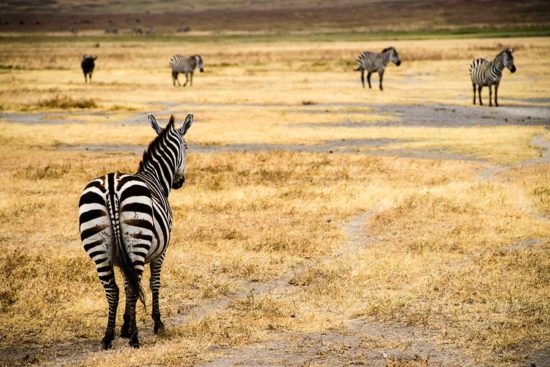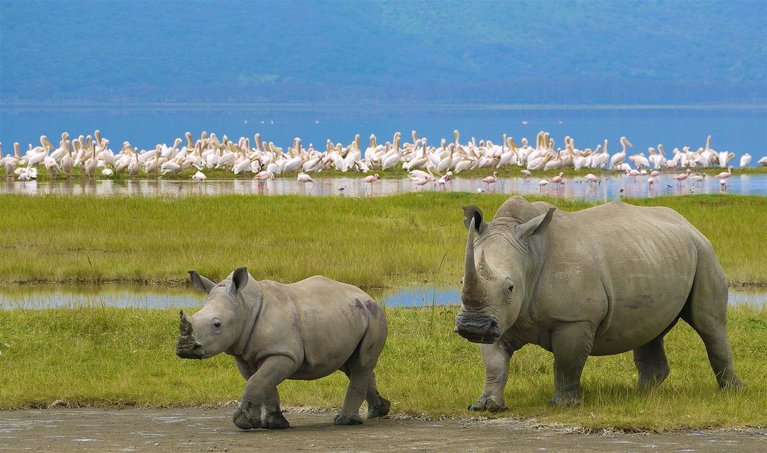Animals in Ngorongoro Crater : The Ngorongoro Crater is the world’s biggest unbroken and unfilled volcanic caldera and the Ngorongoro conservation area’s main tourist attraction. The crater is an extinct volcano filled with species that may be observed all year. However, the grass can be tall at times, making it difficult to comfortably watch them. The sole exception is the iconic giraffe, which is not found inside the crater but can be seen outside in other Ngorongoro conservation areas. The only reason they are not found inside the crater is because the crater walls are steep, making it difficult for them to descend inside. Elephants and other big and small fives are plentiful also can be observed in a great and simple way.

The Ngorongoro crater, which covers 260 square kilometers and has a diameter of roughly 20 kilometers, is actually a massive caldera of a volcano that fell to a depth of 610 meters around two or three million years ago. Streams of water eventually made their way down the crater, forming little ponds, and vegetation grew all around drawing and supporting a variety of wild creatures, both flora and fauna, birds, mammals, invertebrates, amphibians etc.
Over 25,000 creatures live in the crater, including huge mammals like elephants, buffaloes, elands, wildebeests, zebras, gazelles, hippos, and rhinos, as well as carnivores like lions, hyenas, jackals, leopards, and cheetahs. The ponds, or small lakes, on the crater’s bottom are home to a variety of aquatic birds, including flamingos and pelicans. Away from the crater floor, the crater rim woodlands are home to leopards, reedbuck, warthogs, and forest birds, making it Africa’s ultimate destination for game/ animal viewing more especial the iconic “Big Five” (lion, elephant, rhino, leopard, and buffalo).
Apart from the Serengeti National Park, the Ngorongoro Crater is a good location for viewing the Big Five (lions, leopards, elephants, buffalo, and rhinos) in their natural habitat. In their confrontations with herbivores such as wildebeest and gazelles, lions and cheetahs can be seen trying to achieve what is known as “survival of the fittest,” which means that those with the most power survive, and all of this can be seen within the Ngorongoro crater.

According to statistics, there are over 7,000 wildebeest, 6,000 spotted hyenas, 4,000 zebras, 3,000 elands, 3,000 gazelles, 300 elephants, over 55 lions, and 30 black rhinos in the Ngorongoro crater (these are special case animals due to their IUCN status; they are about to go extinct now that they are under proper conservation. Their tracks are known everywhere they go due to electronics implemented on them, and this helps the Ngorongoro conservation area authority to know exactly where they are going so as to avoid any dangerous situations such as poaching). Apart from those mentioned, the crater also hosts a larger number of small mammals such as honey budges, which by combining them with the other mentioned, comes to about 25,000 or above animals in the crater.
A vast variety of water birds, including flamingos and pelicans, can be found in the crater due to the establishment of various habitats such as ponds or very small lakes on the crater’s floor. The Ngorongoro crater is thought to be home to around 500 bird species, including both small and large birds, as well as various water-loving and non-water bird species. Birders consider the crater to be a hotspot for birding because it is simple to see and watch them in a short period of time. It is possible to see both migratory and resident birds, Animals in Ngorongoro Crater.
Apart from flamingos and pelicans, secretary birds are among the most commonly seen and heard birds. However, you may wonder why they are named “secretary birds.” Do they work in offices as secretaries? The origins of the secretary bird’s name are, in reality, hotly debated. The feathers protruding from behind the bird’s head, according to one explanation, reminded 19th-century Europeans of the quill pens that secretaries tucked behind their ears, while the grey and black body resembled their tailcoats. According to a more contemporary hypothesis, the name comes from the Arabic word “saqr-et-tair,” which means “hunting bird.” The secretary bird is a large raptor that can be found in Sub-Saharan Africa’s grasslands and savannah. It’s one of just two raptors that prefers to hunt on foot, you can make you tour visit today in the Ngorongoro conservation area so as you can see all of these including these majestic birds. The crater’s other common birds are ostriches, Kori bastards, and open-billed storks, to name a few.

WHEN IS THE BEST TIME TO VISIT THE NGORONGORO CRATER FOR WILDLIFE VIEWING?
After knowing what animals are present within the crater now you might be asking yourself when should I go to see these creatures in the Ngorongoro crater?, Throughout the year, wildlife watching is great in the crater. The crater’s beauty is most stunning during the wet season, which runs from November to May. The grass may be long in spots. This can make it difficult to see some of the small species. The wettest months are March and April. In light of this, the rainy season, which runs from April to May, is typically regarded as the best time to visit the Ngorongoro Crater, as there are significantly fewer visitors and the crater is lush and green in comparison to the dusty dry-season terrain.
During your visit to the Ngorongoro conservation area, a game drive is the best way to see wildlife in the crater. A game drive allows you to see both mammals and birds, and you can go on a day or night game drive. Day game drives are used to see birds and animals that are active during the day, while night game drives are used to see animals that are active at night, such as leopards. You can also choose to view wildlife within the crater by going on a walking Tanzania safari tour , which is a risky tourist activity but more rewarding than game drives because it allows you to get closer to nature and interact with it in the crater, as well as see animals up close. This is always done with a game ranger to ensure your safety from dangerous animals.


